Yi Zeng
MVPBench: A Benchmark and Fine-Tuning Framework for Aligning Large Language Models with Diverse Human Values
Sep 09, 2025Abstract:The alignment of large language models (LLMs) with human values is critical for their safe and effective deployment across diverse user populations. However, existing benchmarks often neglect cultural and demographic diversity, leading to limited understanding of how value alignment generalizes globally. In this work, we introduce MVPBench, a novel benchmark that systematically evaluates LLMs' alignment with multi-dimensional human value preferences across 75 countries. MVPBench contains 24,020 high-quality instances annotated with fine-grained value labels, personalized questions, and rich demographic metadata, making it the most comprehensive resource of its kind to date. Using MVPBench, we conduct an in-depth analysis of several state-of-the-art LLMs, revealing substantial disparities in alignment performance across geographic and demographic lines. We further demonstrate that lightweight fine-tuning methods, such as Low-Rank Adaptation (LoRA) and Direct Preference Optimization (DPO), can significantly enhance value alignment in both in-domain and out-of-domain settings. Our findings underscore the necessity for population-aware alignment evaluation and provide actionable insights for building culturally adaptive and value-sensitive LLMs. MVPBench serves as a practical foundation for future research on global alignment, personalized value modeling, and equitable AI development.
The Singapore Consensus on Global AI Safety Research Priorities
Jun 25, 2025Abstract:Rapidly improving AI capabilities and autonomy hold significant promise of transformation, but are also driving vigorous debate on how to ensure that AI is safe, i.e., trustworthy, reliable, and secure. Building a trusted ecosystem is therefore essential -- it helps people embrace AI with confidence and gives maximal space for innovation while avoiding backlash. The "2025 Singapore Conference on AI (SCAI): International Scientific Exchange on AI Safety" aimed to support research in this space by bringing together AI scientists across geographies to identify and synthesise research priorities in AI safety. This resulting report builds on the International AI Safety Report chaired by Yoshua Bengio and backed by 33 governments. By adopting a defence-in-depth model, this report organises AI safety research domains into three types: challenges with creating trustworthy AI systems (Development), challenges with evaluating their risks (Assessment), and challenges with monitoring and intervening after deployment (Control).
PandaGuard: Systematic Evaluation of LLM Safety against Jailbreaking Attacks
May 22, 2025Abstract:Large language models (LLMs) have achieved remarkable capabilities but remain vulnerable to adversarial prompts known as jailbreaks, which can bypass safety alignment and elicit harmful outputs. Despite growing efforts in LLM safety research, existing evaluations are often fragmented, focused on isolated attack or defense techniques, and lack systematic, reproducible analysis. In this work, we introduce PandaGuard, a unified and modular framework that models LLM jailbreak safety as a multi-agent system comprising attackers, defenders, and judges. Our framework implements 19 attack methods and 12 defense mechanisms, along with multiple judgment strategies, all within a flexible plugin architecture supporting diverse LLM interfaces, multiple interaction modes, and configuration-driven experimentation that enhances reproducibility and practical deployment. Built on this framework, we develop PandaBench, a comprehensive benchmark that evaluates the interactions between these attack/defense methods across 49 LLMs and various judgment approaches, requiring over 3 billion tokens to execute. Our extensive evaluation reveals key insights into model vulnerabilities, defense cost-performance trade-offs, and judge consistency. We find that no single defense is optimal across all dimensions and that judge disagreement introduces nontrivial variance in safety assessments. We release the code, configurations, and evaluation results to support transparent and reproducible research in LLM safety.
STEP: A Unified Spiking Transformer Evaluation Platform for Fair and Reproducible Benchmarking
May 16, 2025Abstract:Spiking Transformers have recently emerged as promising architectures for combining the efficiency of spiking neural networks with the representational power of self-attention. However, the lack of standardized implementations, evaluation pipelines, and consistent design choices has hindered fair comparison and principled analysis. In this paper, we introduce \textbf{STEP}, a unified benchmark framework for Spiking Transformers that supports a wide range of tasks, including classification, segmentation, and detection across static, event-based, and sequential datasets. STEP provides modular support for diverse components such as spiking neurons, input encodings, surrogate gradients, and multiple backends (e.g., SpikingJelly, BrainCog). Using STEP, we reproduce and evaluate several representative models, and conduct systematic ablation studies on attention design, neuron types, encoding schemes, and temporal modeling capabilities. We also propose a unified analytical model for energy estimation, accounting for spike sparsity, bitwidth, and memory access, and show that quantized ANNs may offer comparable or better energy efficiency. Our results suggest that current Spiking Transformers rely heavily on convolutional frontends and lack strong temporal modeling, underscoring the need for spike-native architectural innovations. The full code is available at: https://github.com/Fancyssc/STEP
Incorporating brain-inspired mechanisms for multimodal learning in artificial intelligence
May 15, 2025Abstract:Multimodal learning enhances the perceptual capabilities of cognitive systems by integrating information from different sensory modalities. However, existing multimodal fusion research typically assumes static integration, not fully incorporating key dynamic mechanisms found in the brain. Specifically, the brain exhibits an inverse effectiveness phenomenon, wherein weaker unimodal cues yield stronger multisensory integration benefits; conversely, when individual modal cues are stronger, the effect of fusion is diminished. This mechanism enables biological systems to achieve robust cognition even with scarce or noisy perceptual cues. Inspired by this biological mechanism, we explore the relationship between multimodal output and information from individual modalities, proposing an inverse effectiveness driven multimodal fusion (IEMF) strategy. By incorporating this strategy into neural networks, we achieve more efficient integration with improved model performance and computational efficiency, demonstrating up to 50% reduction in computational cost across diverse fusion methods. We conduct experiments on audio-visual classification, continual learning, and question answering tasks to validate our method. Results consistently demonstrate that our method performs excellently in these tasks. To verify universality and generalization, we also conduct experiments on Artificial Neural Networks (ANN) and Spiking Neural Networks (SNN), with results showing good adaptability to both network types. Our research emphasizes the potential of incorporating biologically inspired mechanisms into multimodal networks and provides promising directions for the future development of multimodal artificial intelligence. The code is available at https://github.com/Brain-Cog-Lab/IEMF.
Redefining Superalignment: From Weak-to-Strong Alignment to Human-AI Co-Alignment to Sustainable Symbiotic Society
Apr 24, 2025Abstract:Artificial Intelligence (AI) systems are becoming increasingly powerful and autonomous, and may progress to surpass human intelligence levels, namely Artificial Superintelligence (ASI). During the progression from AI to ASI, it may exceed human control, violate human values, and even lead to irreversible catastrophic consequences in extreme cases. This gives rise to a pressing issue that needs to be addressed: superalignment, ensuring that AI systems much smarter than humans, remain aligned with human (compatible) intentions and values. Existing scalable oversight and weak-to-strong generalization methods may prove substantially infeasible and inadequate when facing ASI. We must explore safer and more pluralistic frameworks and approaches for superalignment. In this paper, we redefine superalignment as the human-AI co-alignment towards a sustainable symbiotic society, and highlight a framework that integrates external oversight and intrinsic proactive alignment. External oversight superalignment should be grounded in human-centered ultimate decision, supplemented by interpretable automated evaluation and correction, to achieve continuous alignment with humanity's evolving values. Intrinsic proactive superalignment is rooted in a profound understanding of the self, others, and society, integrating self-awareness, self-reflection, and empathy to spontaneously infer human intentions, distinguishing good from evil and proactively considering human well-being, ultimately attaining human-AI co-alignment through iterative interaction. The integration of externally-driven oversight with intrinsically-driven proactive alignment empowers sustainable symbiotic societies through human-AI co-alignment, paving the way for achieving safe and beneficial AGI and ASI for good, for human, and for a symbiotic ecology.
Continual Learning of Multiple Cognitive Functions with Brain-inspired Temporal Development Mechanism
Apr 08, 2025Abstract:Cognitive functions in current artificial intelligence networks are tied to the exponential increase in network scale, whereas the human brain can continuously learn hundreds of cognitive functions with remarkably low energy consumption. This advantage is in part due to the brain cross-regional temporal development mechanisms, where the progressive formation, reorganization, and pruning of connections from basic to advanced regions, facilitate knowledge transfer and prevent network redundancy. Inspired by these, we propose the Continual Learning of Multiple Cognitive Functions with Brain-inspired Temporal Development Mechanism(TD-MCL), enabling cognitive enhancement from simple to complex in Perception-Motor-Interaction(PMI) multiple cognitive task scenarios. The TD-MCL model proposes the sequential evolution of long-range connections between different cognitive modules to promote positive knowledge transfer, while using feedback-guided local connection inhibition and pruning to effectively eliminate redundancies in previous tasks, reducing energy consumption while preserving acquired knowledge. Experiments show that the proposed method can achieve continual learning capabilities while reducing network scale, without introducing regularization, replay, or freezing strategies, and achieving superior accuracy on new tasks compared to direct learning. The proposed method shows that the brain's developmental mechanisms offer a valuable reference for exploring biologically plausible, low-energy enhancements of general cognitive abilities.
Overcoming the Identity Mapping Problem in Self-Supervised Hyperspectral Anomaly Detection
Apr 05, 2025Abstract:The surge of deep learning has catalyzed considerable progress in self-supervised Hyperspectral Anomaly Detection (HAD). The core premise for self-supervised HAD is that anomalous pixels are inherently more challenging to reconstruct, resulting in larger errors compared to the background. However, owing to the powerful nonlinear fitting capabilities of neural networks, self-supervised models often suffer from the Identity Mapping Problem (IMP). The IMP manifests as a tendency for the model to overfit to the entire image, particularly with increasing network complexity or prolonged training iterations. Consequently, the whole image can be precisely reconstructed, and even the anomalous pixels exhibit imperceptible errors, making them difficult to detect. Despite the proposal of several models aimed at addressing the IMP-related issues, a unified descriptive framework and validation of solutions for IMP remain lacking. In this paper, we conduct an in-depth exploration to IMP, and summarize a unified framework that describes IMP from the perspective of network optimization, which encompasses three aspects: perturbation, reconstruction, and regularization. Correspondingly, we introduce three solutions: superpixel pooling and uppooling for perturbation, error-adaptive convolution for reconstruction, and online background pixel mining for regularization. With extensive experiments being conducted to validate the effectiveness, it is hoped that our work will provide valuable insights and inspire further research for self-supervised HAD. Code: \url{https://github.com/yc-cui/Super-AD}.
Biologically Inspired Spiking Diffusion Model with Adaptive Lateral Selection Mechanism
Mar 31, 2025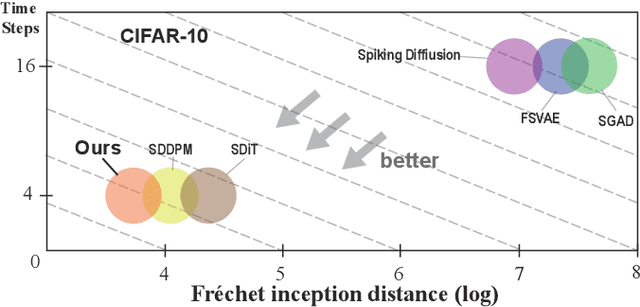

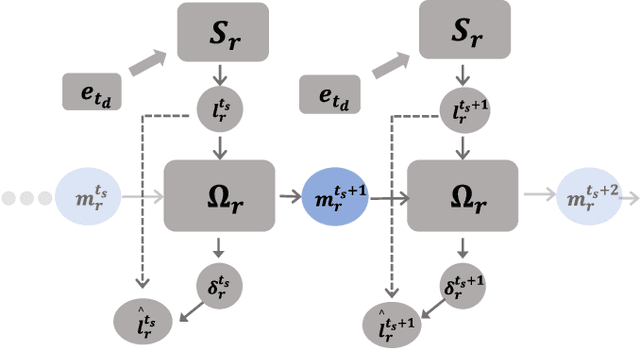

Abstract:Lateral connection is a fundamental feature of biological neural circuits, facilitating local information processing and adaptive learning. In this work, we integrate lateral connections with a substructure selection network to develop a novel diffusion model based on spiking neural networks (SNNs). Unlike conventional artificial neural networks, SNNs employ an intrinsic spiking inner loop to process sequential binary spikes. We leverage this spiking inner loop alongside a lateral connection mechanism to iteratively refine the substructure selection network, enhancing model adaptability and expressivity. Specifically, we design a lateral connection framework comprising a learnable lateral matrix and a lateral mapping function, both implemented using spiking neurons, to dynamically update lateral connections. Through mathematical modeling, we establish that the proposed lateral update mechanism, under a well-defined local objective, aligns with biologically plausible synaptic plasticity principles. Extensive experiments validate the effectiveness of our approach, analyzing the role of substructure selection and lateral connection during training. Furthermore, quantitative comparisons demonstrate that our model consistently surpasses state-of-the-art SNN-based generative models across multiple benchmark datasets.
Adaptive Interactive Navigation of Quadruped Robots using Large Language Models
Mar 29, 2025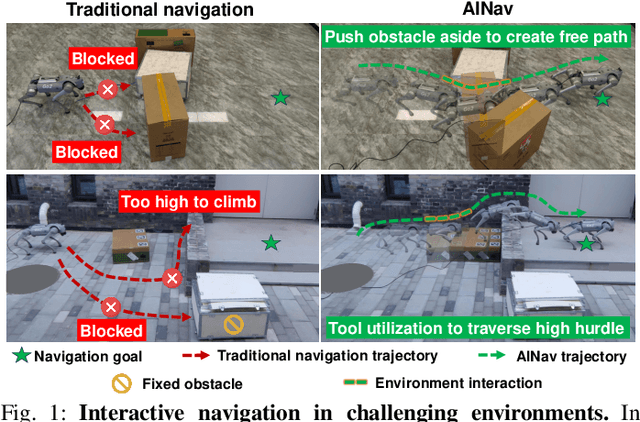
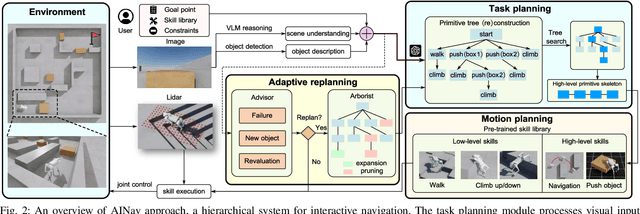

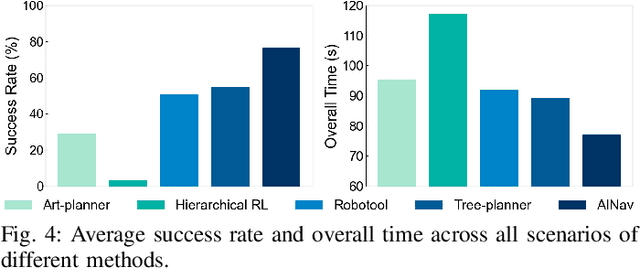
Abstract:Robotic navigation in complex environments remains a critical research challenge. Traditional navigation methods focus on optimal trajectory generation within free space, struggling in environments lacking viable paths to the goal, such as disaster zones or cluttered warehouses. To address this gap, we propose an adaptive interactive navigation approach that proactively interacts with environments to create feasible paths to reach originally unavailable goals. Specifically, we present a primitive tree for task planning with large language models (LLMs), facilitating effective reasoning to determine interaction objects and sequences. To ensure robust subtask execution, we adopt reinforcement learning to pre-train a comprehensive skill library containing versatile locomotion and interaction behaviors for motion planning. Furthermore, we introduce an adaptive replanning method featuring two LLM-based modules: an advisor serving as a flexible replanning trigger and an arborist for autonomous plan adjustment. Integrated with the tree structure, the replanning mechanism allows for convenient node addition and pruning, enabling rapid plan modification in unknown environments. Comprehensive simulations and experiments have demonstrated our method's effectiveness and adaptivity in diverse scenarios. The supplementary video is available at page: https://youtu.be/W5ttPnSap2g.
 Add to Chrome
Add to Chrome Add to Firefox
Add to Firefox Add to Edge
Add to Edge